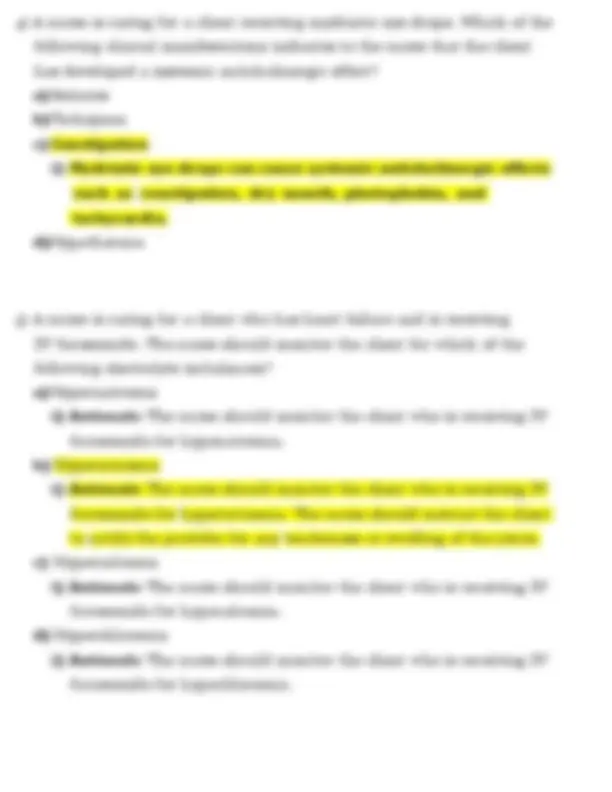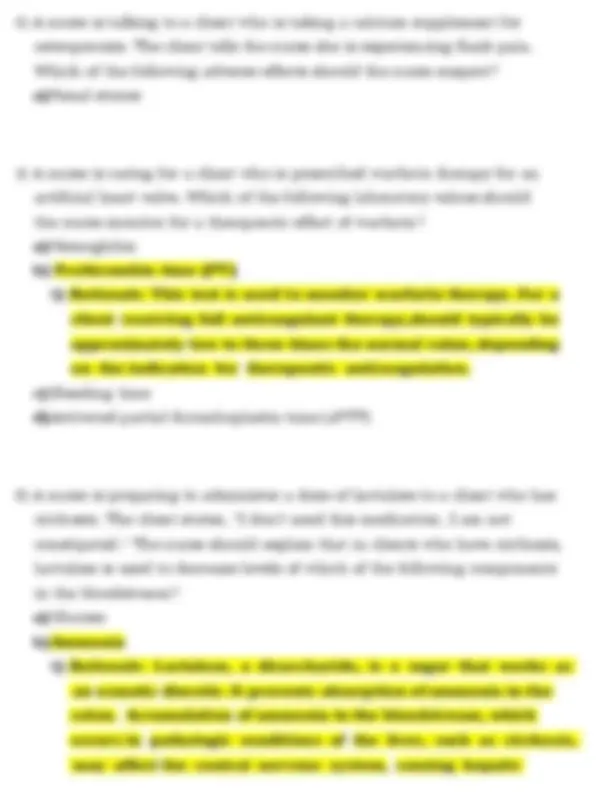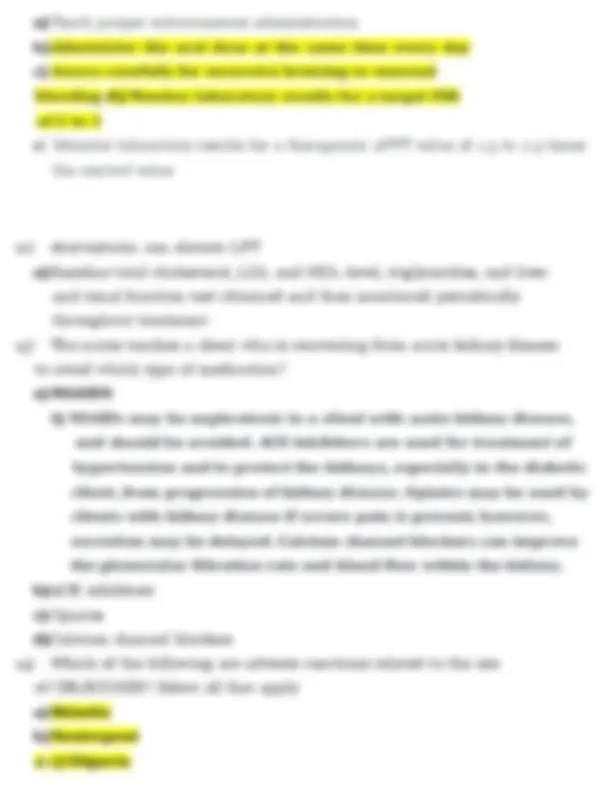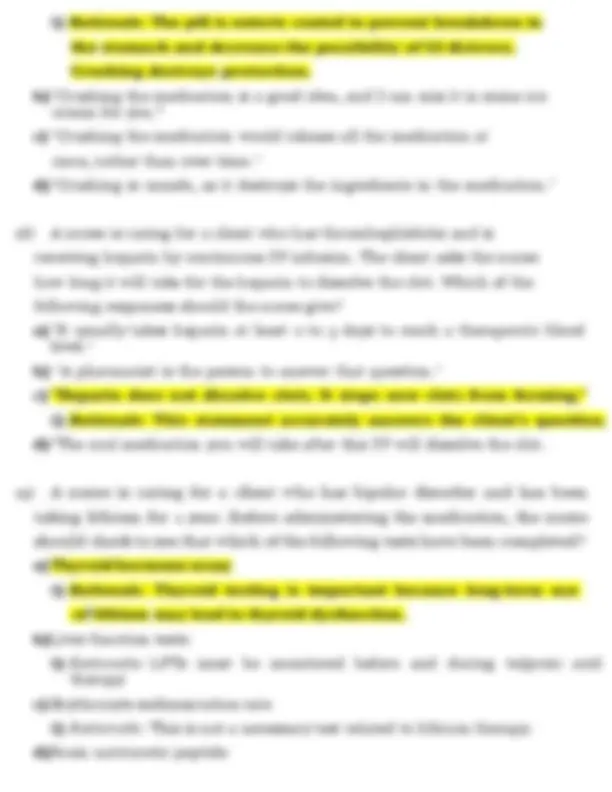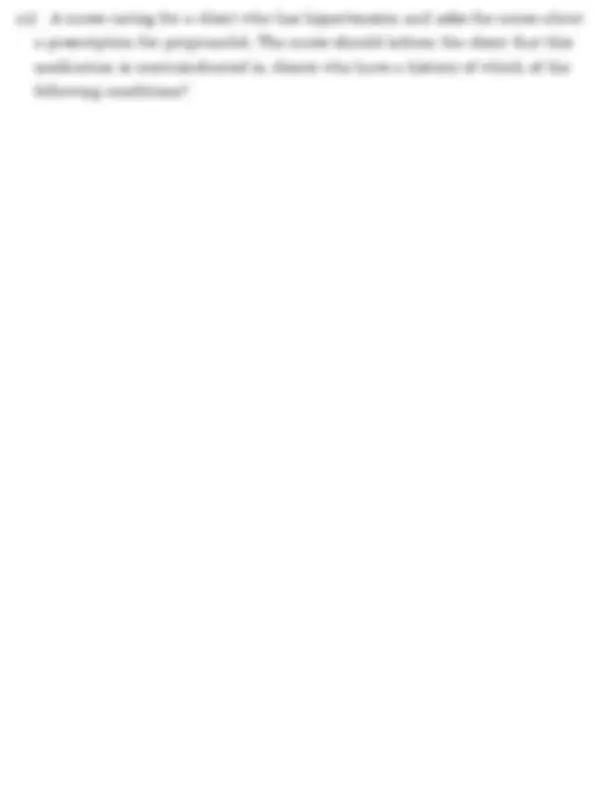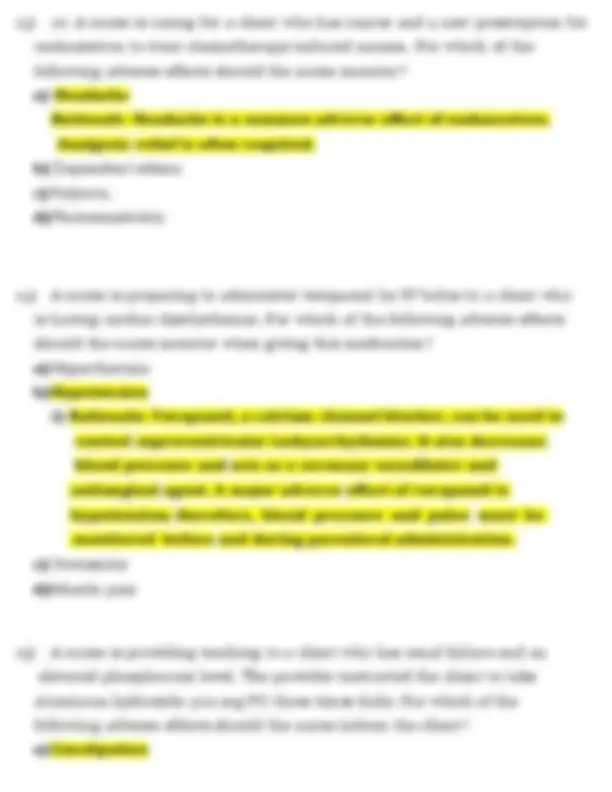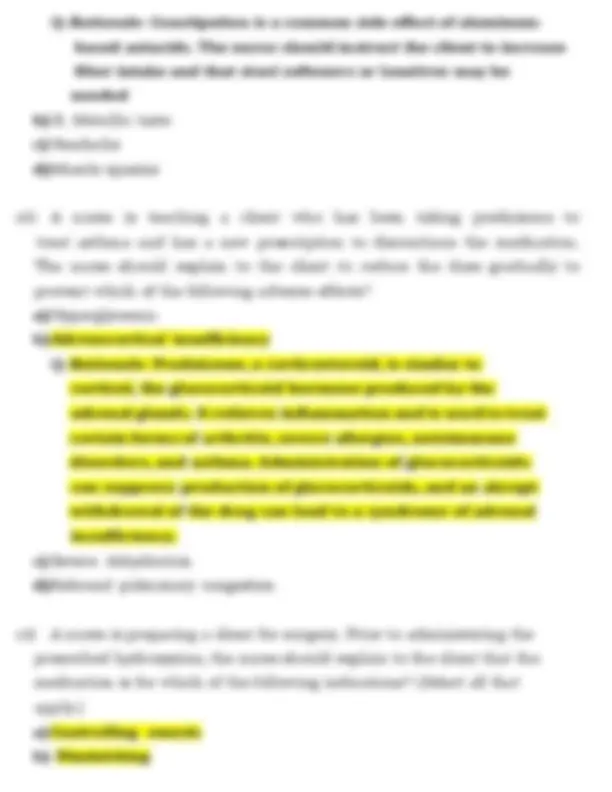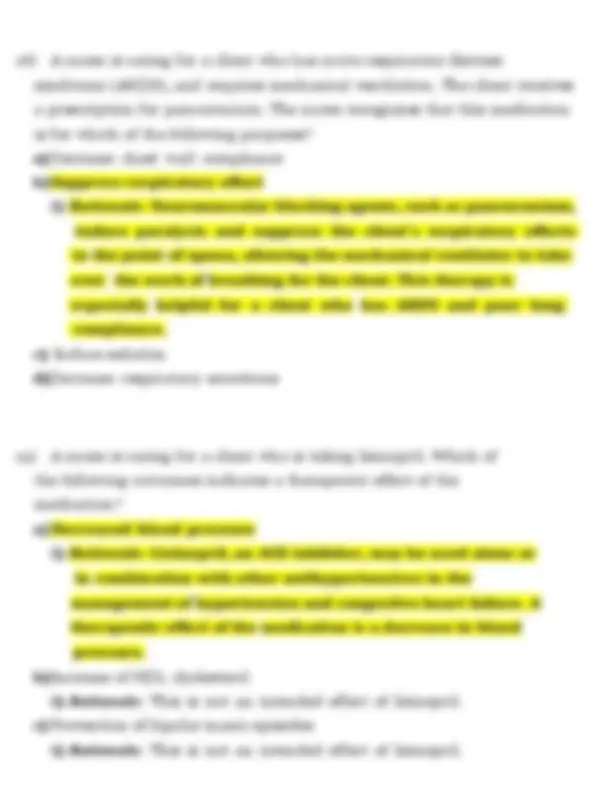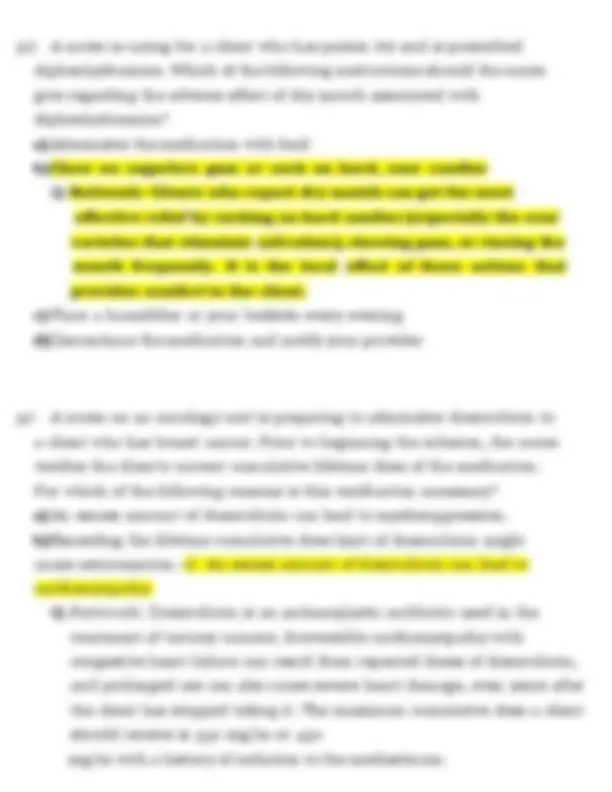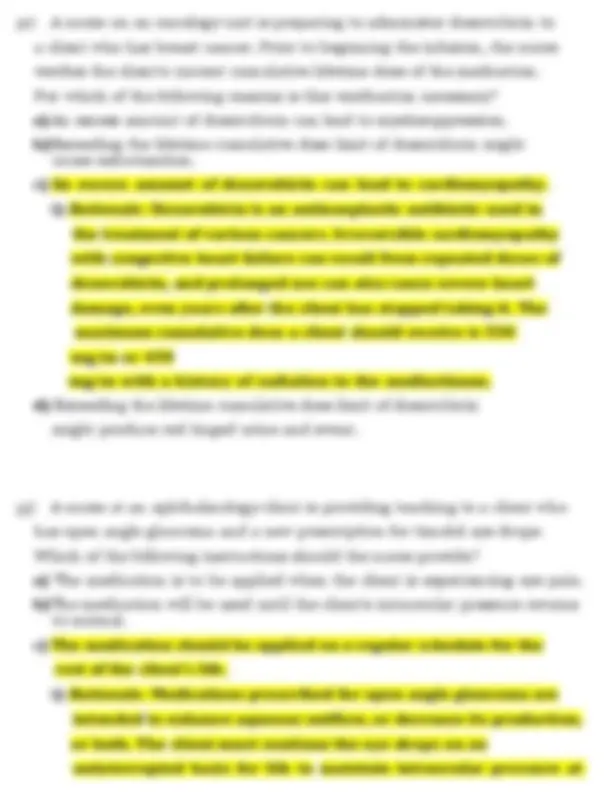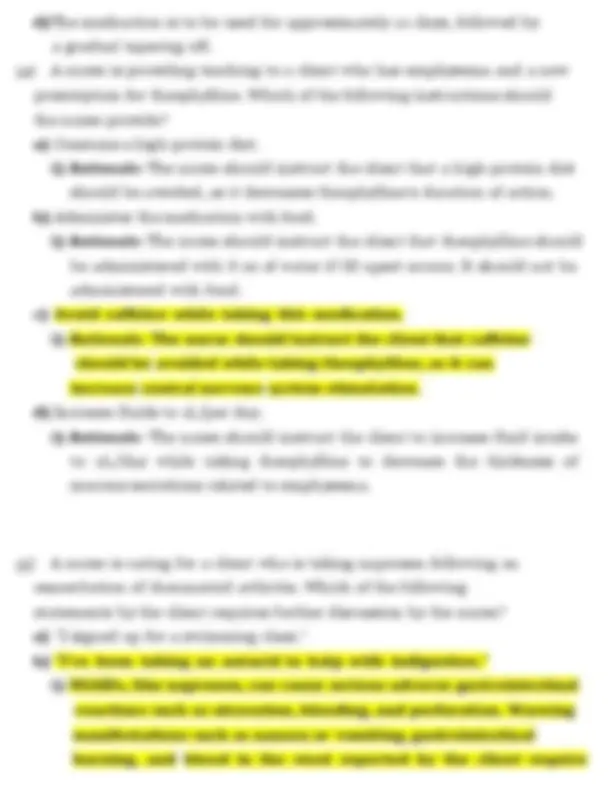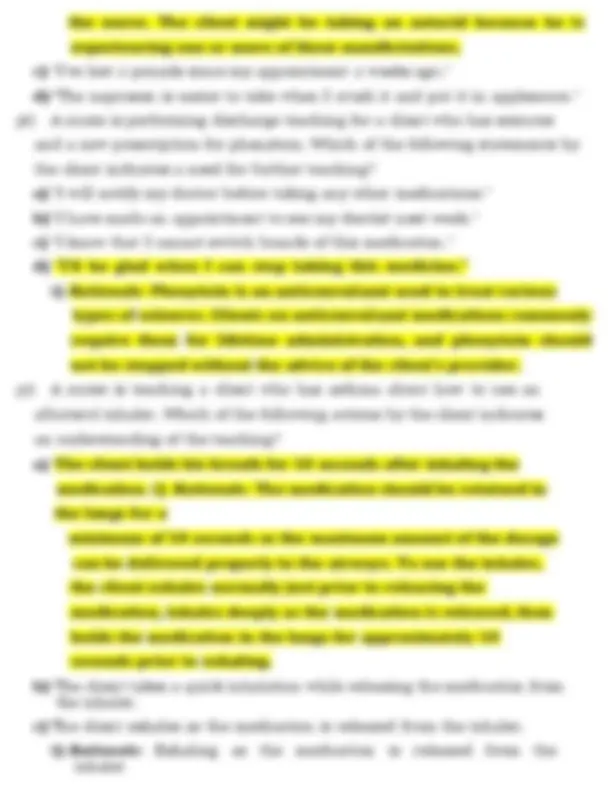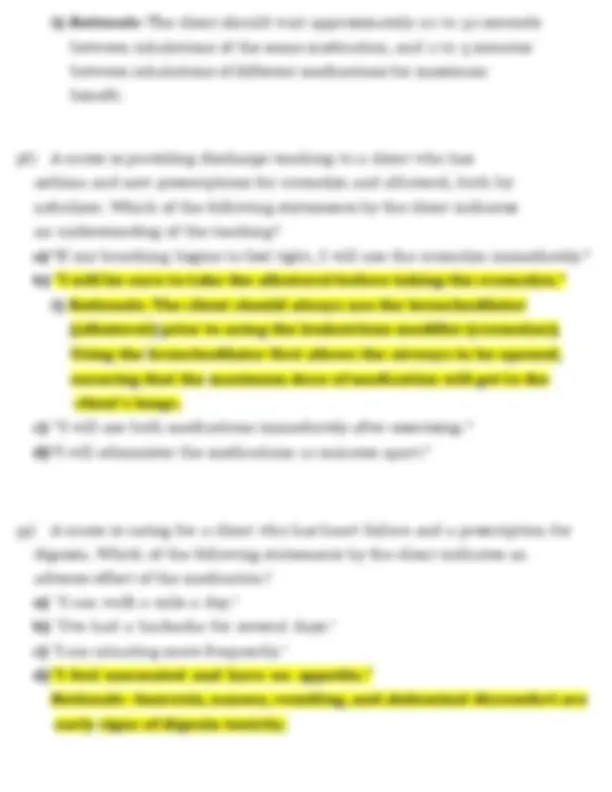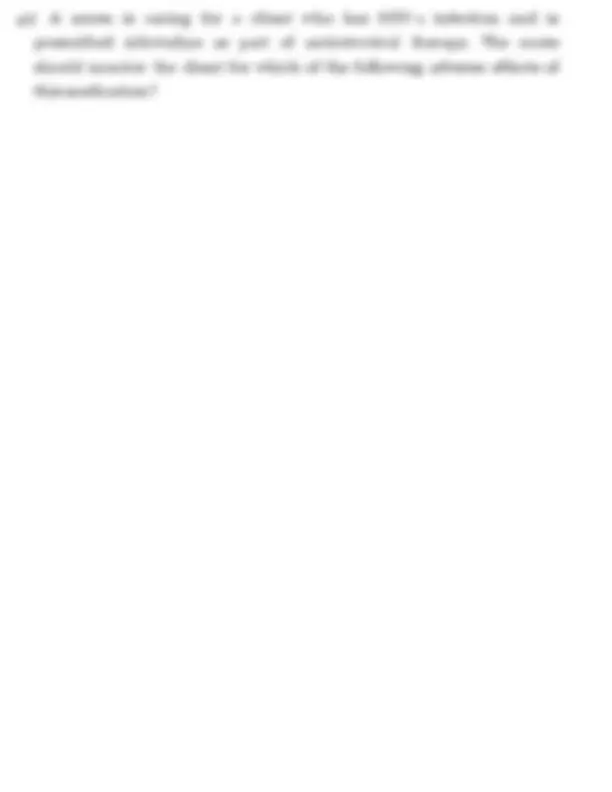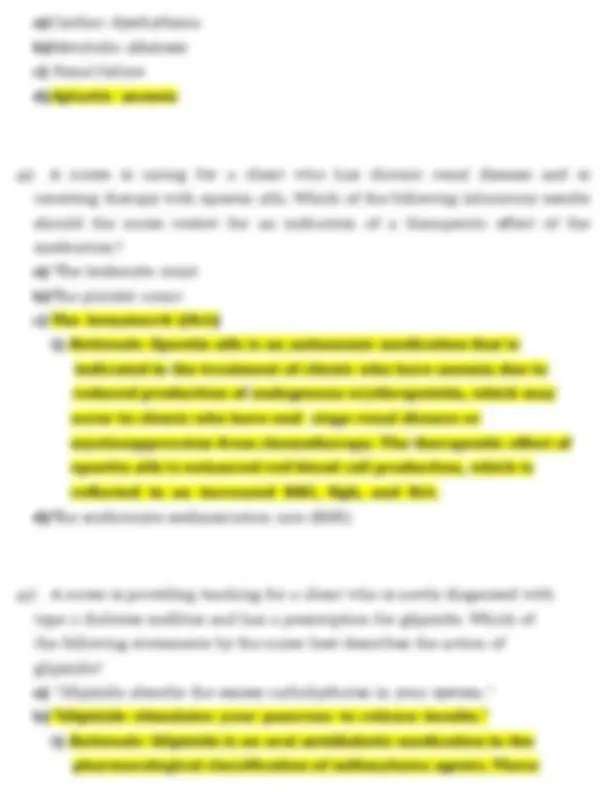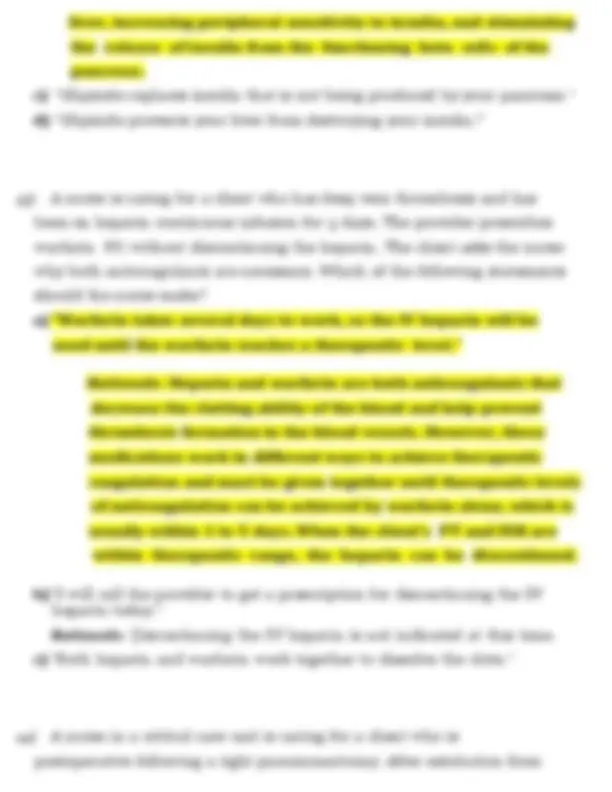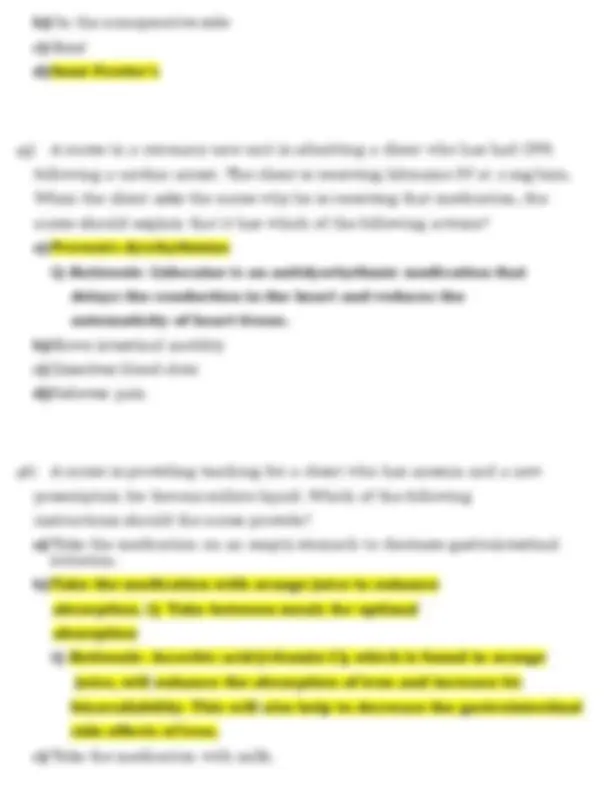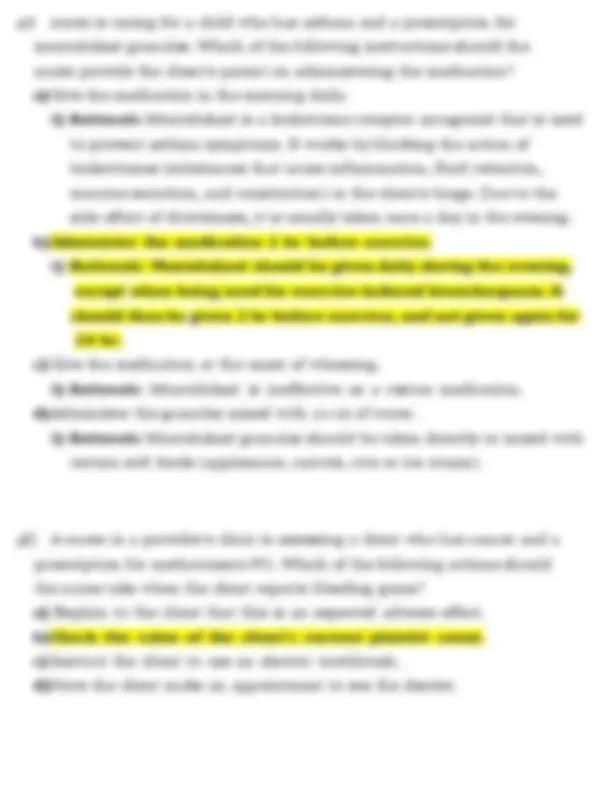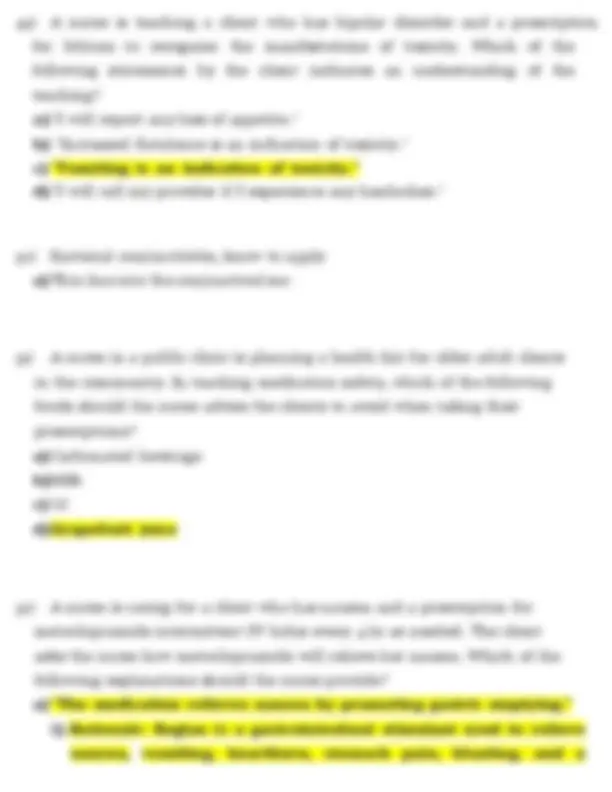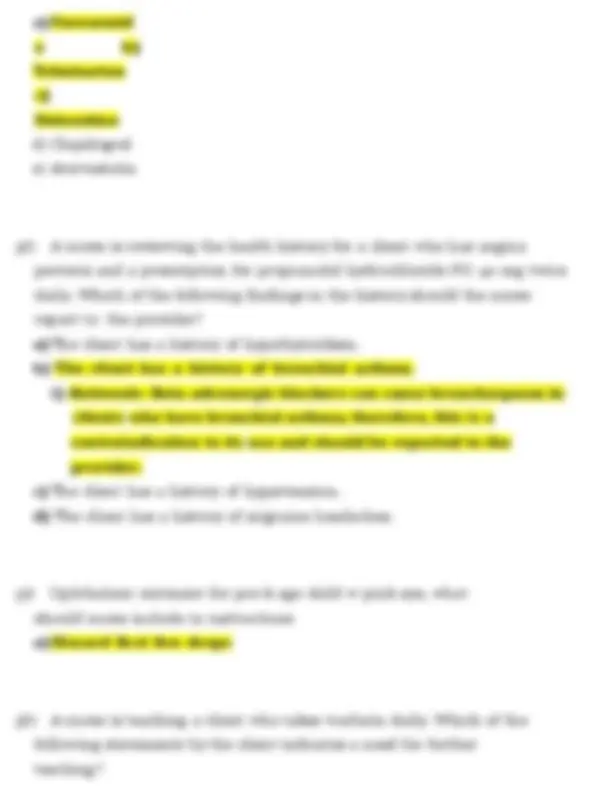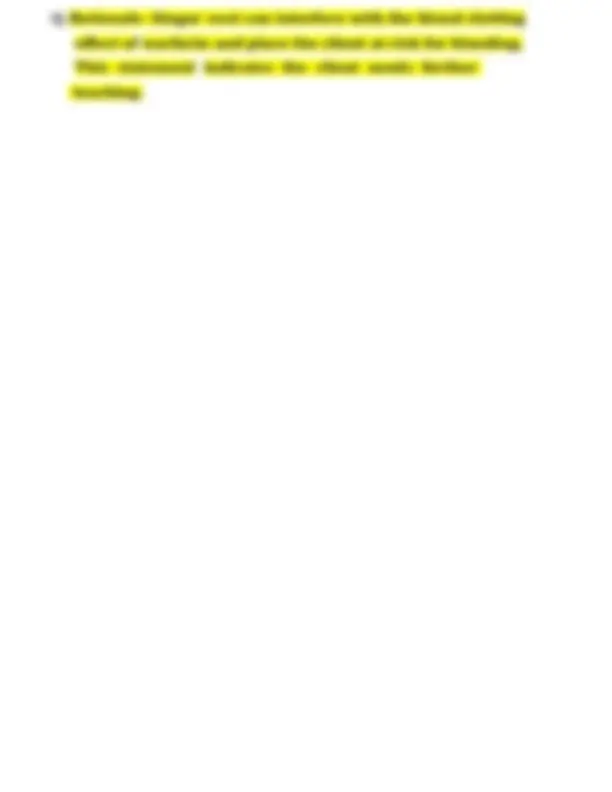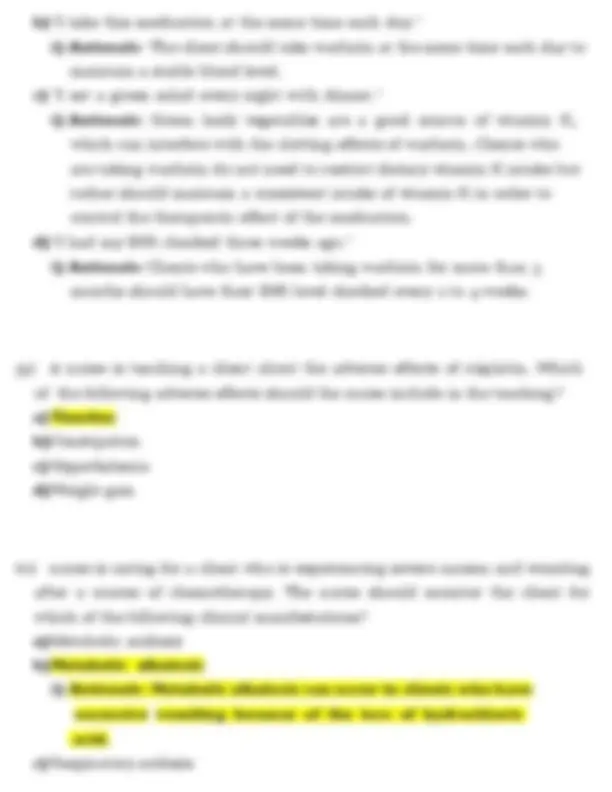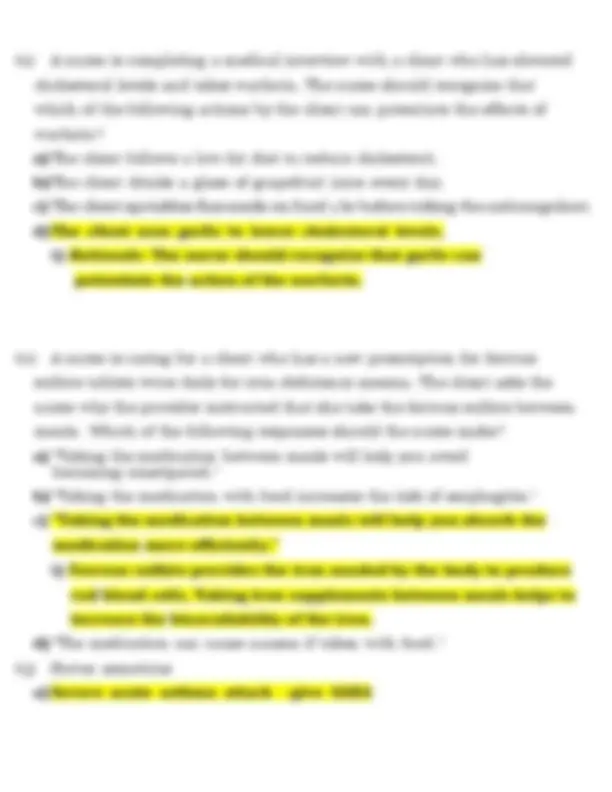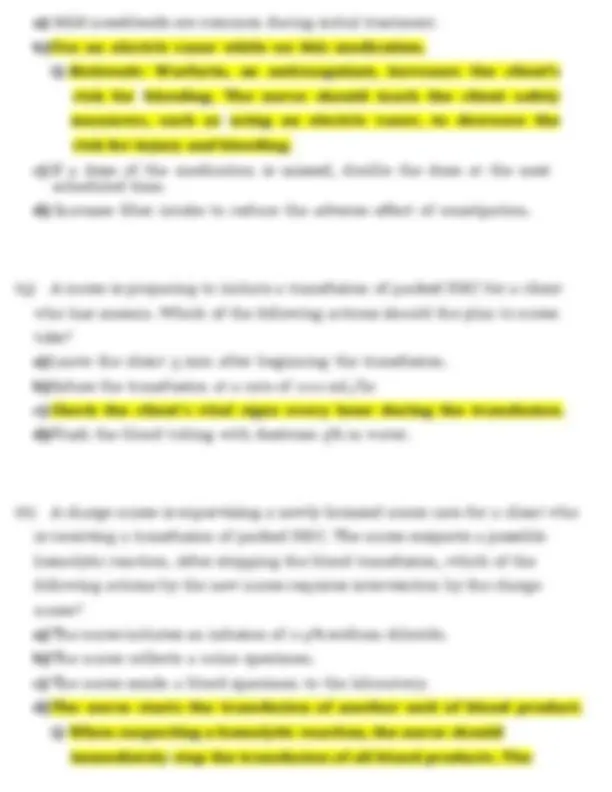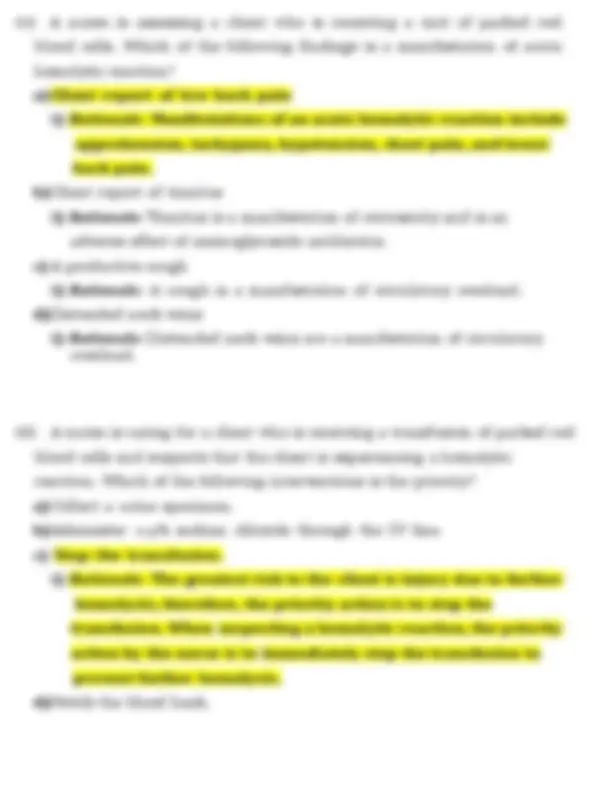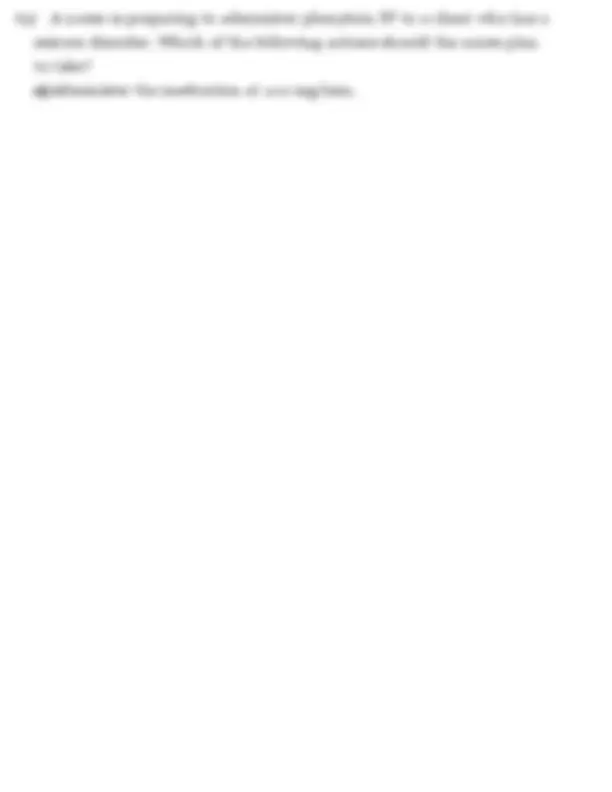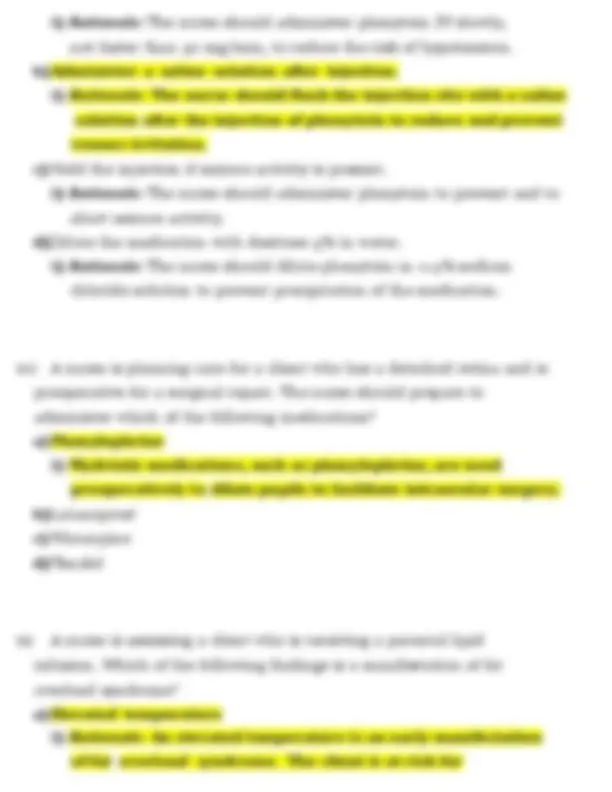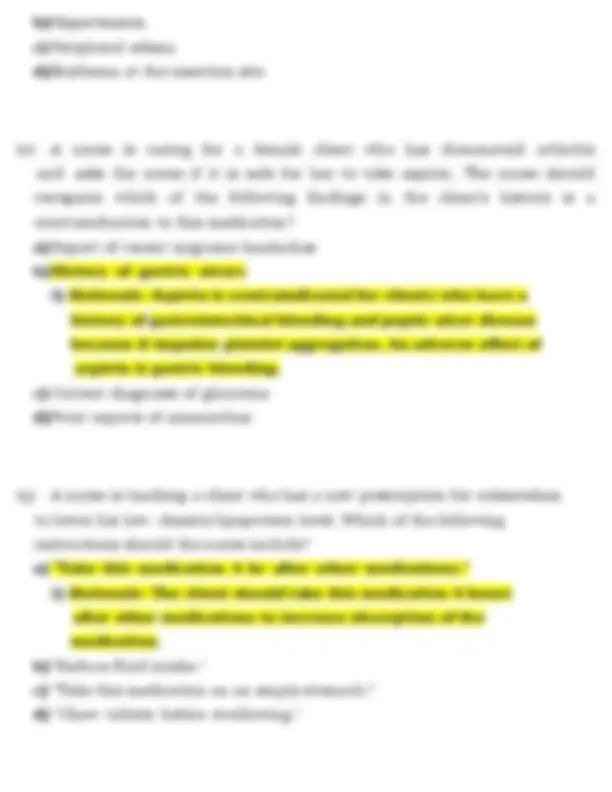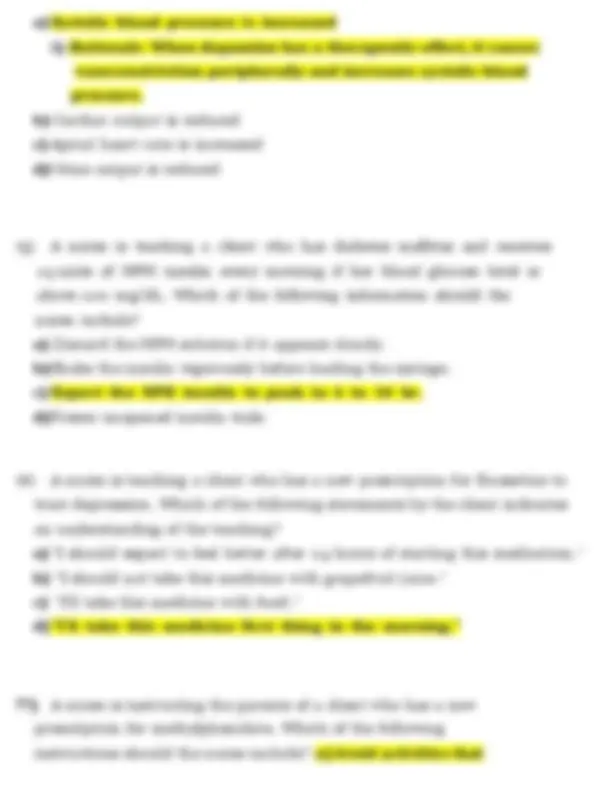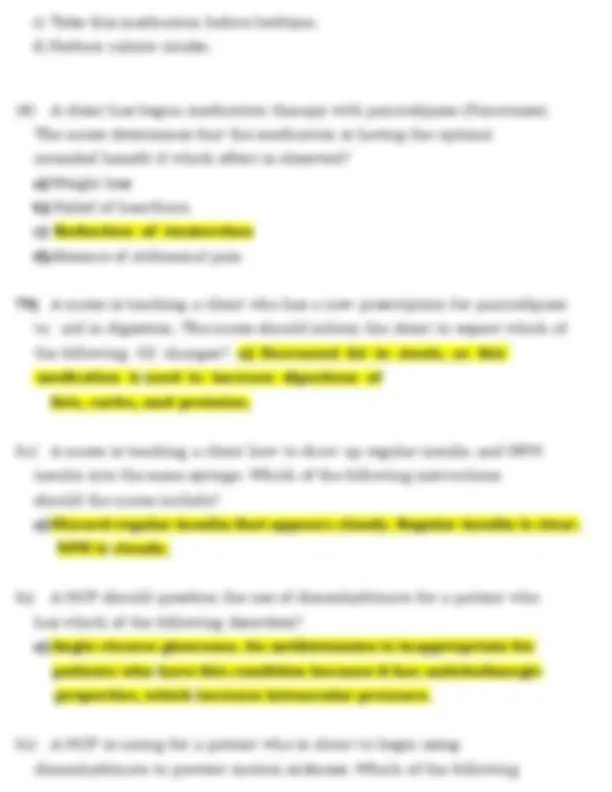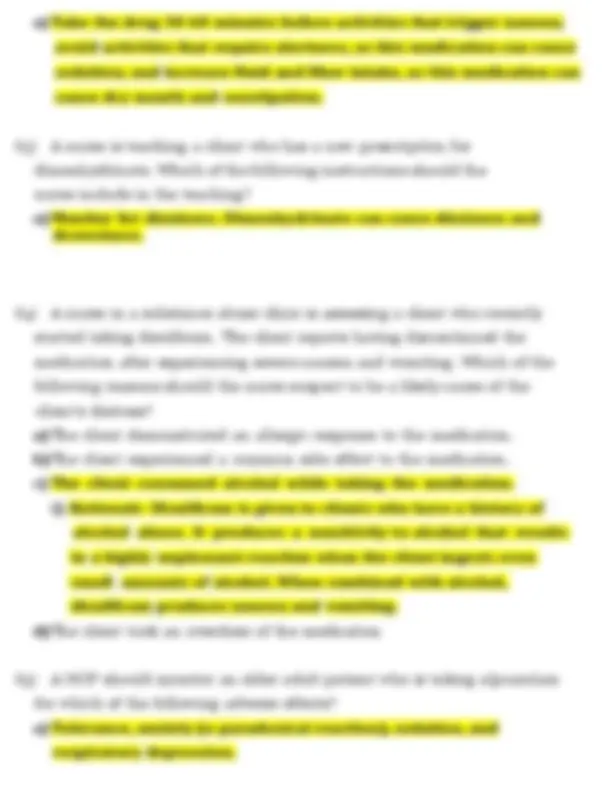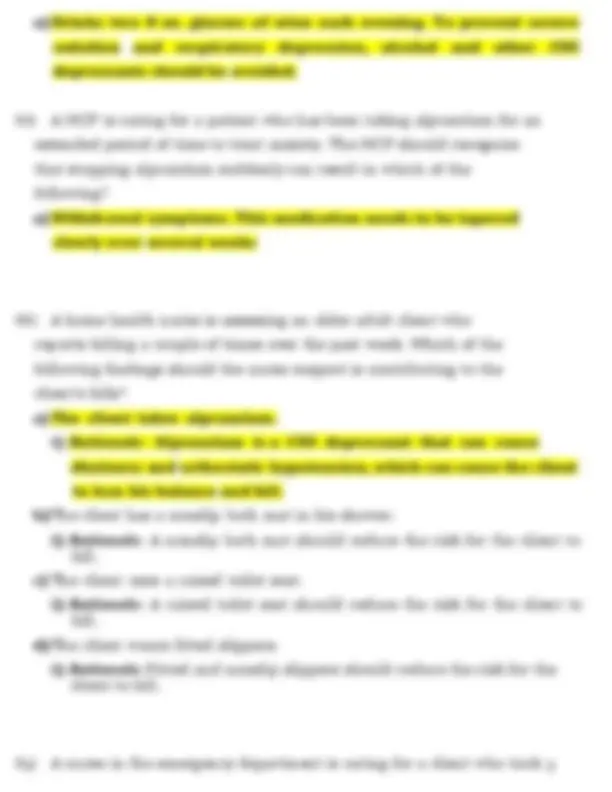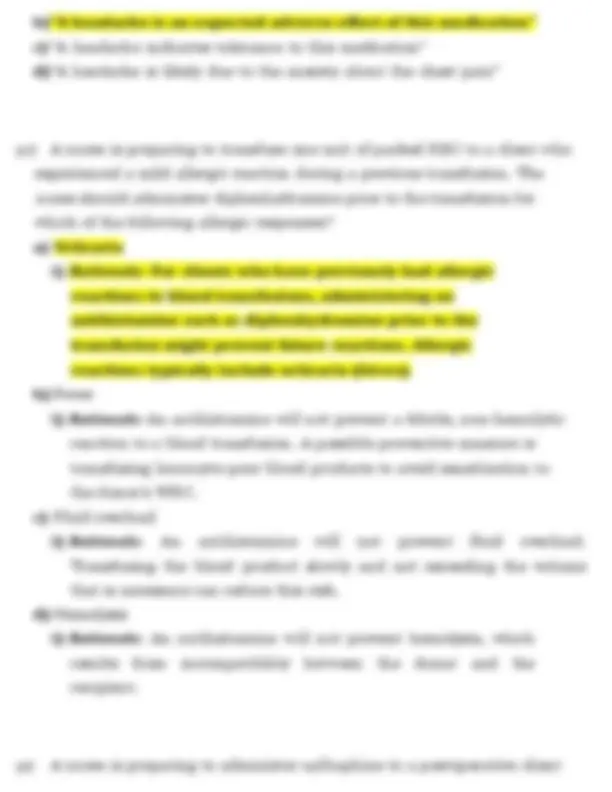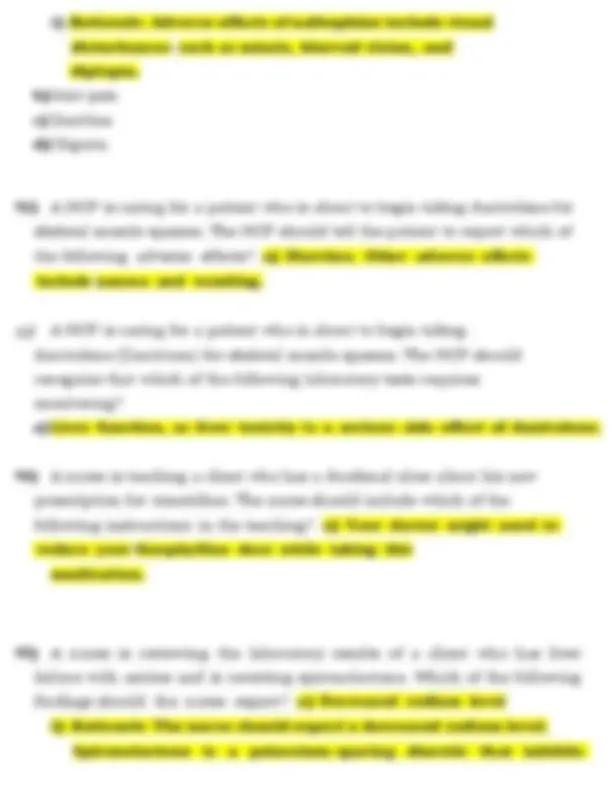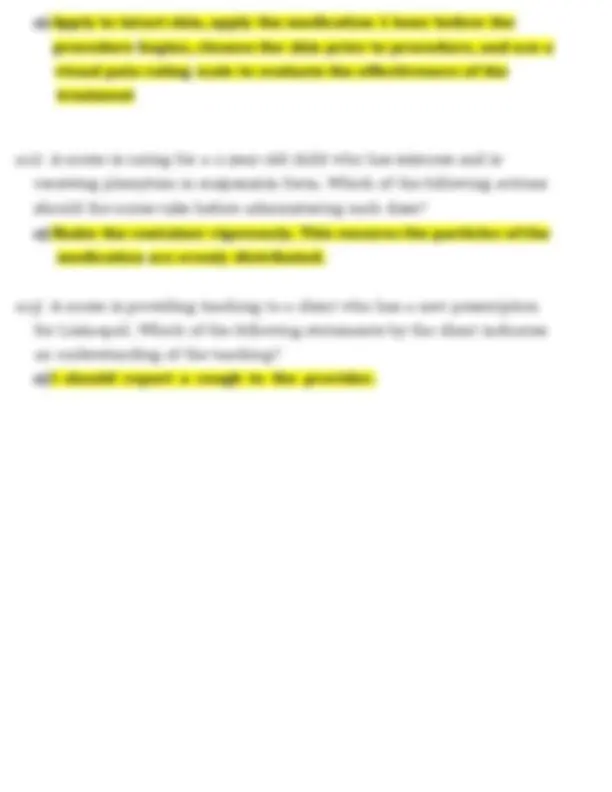Download ATI Pharmacology Final Review Questions With Answers 100% Correct 2025.pdf and more Exams Pharmacology in PDF only on Docsity!
ATI Pharmacology Final Review Questions With
Answers 100% Correct 2025
- A .nurse .is .assessing .a .client .who .is .taking .levothyroxine. .The .nurse .should .recognize .that .which .of .the .following .findings .is .a .manifestation .of .levothyroxine .overdose? a) Insomnia i) Rationale:. Levothyroxine .overdose .will .result .in .manifestations .of .hyperthyroidism, .which .include .Insomnia, .tachycardia, .and .hyperthermia. b) Constipation i) Rationale:. Constipation .is .a .manifestation .of .hypothyroidism .and .indicates .an .inadequate .dose .of .levothyroxine. c) Drowsiness i) Rationale:. Drowsiness .is .a .manifestation .of .hypothyroidism .and .indicates .an .inadequate .dose .of .levothyroxine. d) Hypoactive .deep-tendon .reflexes i) Rationale:. Hypoactive .deep-tendon .reflexes .are .manifestations .of .hypothyroidism .and .indicate .an .inadequate .dose .of .levothyroxine.
- A .nurse .is .reviewing .the .medical .record .of .a .client .who .has .been .on .levothyroxine .for .several .months. .Which .of .the .following .findings .indicates .a .therapeutic .response .to .the .medication? a) Decrease .in .level .of .thyroxine .(T4) i) Rationale:. If .the .dose .of .this .medication .has .been .adequate, .the .nurse .should .see .an .increase .in .the .T4.
b) Increase .in .weight i) Rationale:. If .the .dose .of .this .medication .has .been .adequate, .the .nurse .should .see .a .decrease .in .weight, .as .hypothyroidism .causes .a .decrease .in .metabolism .with .weight .gain. c) Increase .in .hr .of .sleep .per .night i) Rationale:. If .the .dose .of .this .medication .has .been .adequate, .the .nurse .should .see .a .decrease .in .the .hr .of .sleep .per .night, .as .hypothyroidism .causes .sluggishness .with .increased .hr .of .sleep. d) Decrease. in. level. of. thyroid. stimulating .hormone. (TSH). i) Rationale:. In .hypothyroidism, .the .nonfunctioning .thyroid .gland .is
. unable .to .respond .to .the .TSH, .and .no .endogenous .thyroid . hormones .are .released. .This .results .in .an .elevation .of .the .TSH . level .as .the .anterior .pituitary .continues .to .release .the .TSH .to . stimulate .the .thyroid .gland. Administration .of .exogenous .thyroid .hormones, .such .as .levothyroxine, .turns .of .f .this .feedback .loop, .which .results .in .a .decreased .level .of .TSH.
- A .nurse .is .reviewing .the .medication .list .for .a .client .who .has .a .new .diagnosis . of .type. 2 .diabetes .mellitus. .The .nurse .should .recognize .which .of .the .following .medications .can .cause .glucose .intolerance? a) Ranitidine i) Serum .creatinine .levels b) Guafenesin i) Drowsiness .and .dizziness c) Prednisone i) Glucose .intolerance .and .hyperglycemia, .patient .might .require .increased .dosage .of .hypoglycemic .med. d) Atorvastatin i) Thyroid. function. tests.
- A .nurse .is .talking .to .a .client .who .is .taking .a .calcium .supplement .for .osteoporosis. .The .client .tells .the .nurse .she .is .experiencing .flank .pain. .Which .of .the .following .adverse .effects .should .the .nurse .suspect? a) Renal .stones
- A .nurse .is .caring .for .a .client .who .is .prescribed .warfarin .therapy .for .an .artificial .heart .valve. .Which .of .the .following .laboratory .values .should .the .nurse .monitor .for .a .therapeutic .effect .of .warfarin? a) Hemoglobin b) Prothrombin .time .(PT) i) Rationale:. This .test .is .used .to .monitor .warfarin .therapy. .For .a .client .receiving .full .anticoagulant .therapy,should .typically .be .approximately .two .to .three .times .the .normal .value, .depending .on. the .indication. for. therapeutic. anticoagulation. c) Bleeding .time d) Activated .partial .thromboplastin .time .(aPTT)
- A .nurse .is .preparing .to .administer .a .dose .of .lactulose .to .a .client .who .has .cirrhosis. .The .client .states, ."I .don't .need .this .medication. .I .am .not .constipated." .The .nurse .should .explain .that .in .clients .who .have .cirrhosis, .lactulose .is .used .to .decrease .levels .of .which .of .the .following .components .in .the .bloodstream? a) Glucose b) Ammonia i) Rationale:. Lactulose,. a. disaccharide,. is. a. sugar. that. works. as
. an .osmotic .diuretic. .It .prevents .absorption .of .ammonia .in .the .colon.. Accumulation .of .ammonia .in .the .bloodstream, .which .occurs .in. pathologic. conditions. of. the. liver,. such. as. cirrhosis, . may. affect .the. central. nervous. system,. causing. hepatic
. encephalopathy. or
c) Potassium d) Bicarbonate
- A .nurse .is .educating .a .group .of .clients .about .the .contraindications .of .warfarin .therapy. .Which .of .the .following .statements .should .the .nurse .include .in .the .teaching? a) "Clients .who .have .glaucoma .should .not .take .warfarin." b) "Clients .who .have .rheumatoid .arthritis .should .not .take .warfarin." c) "Clients. who. are. pregnant. should. not. take. warfarin." i) Rationale:. Warfarin .therapy .is .contraindicated .in .the .pregnant .client. because. it. crosses. the. placenta. and. places. the. fetus
. at .risk .for .bleeding. d) "Clients .who .have .hyperthyroidism .should .not .take .warfarin."
- A .nurse .is .teaching .a .client .who .takes .warfarin .daily. .Which .of .the .following .statements .by .the .client .indicates .a .need .for .further .teaching? a) "I .have .started .taking .ginger .root .to .treat .my .joint .stiffness." i) Rationale:. Ginger .root .can .interfere .with .the .blood .clotting . effect .of .warfarin .and .place .the .client .at .risk .for .bleeding. . This. statement. indicates. the. client. needs. further . teaching. b) "I .take .this .medication .at .the .same .time .each .day." i) Rationale:. The .client .should .take .warfarin .at .the .same .time .each .day .to .maintain .a .stable .blood .level. c) "I .eat .a .green .salad .every .night .with .dinner." i) Rationale:. Green. leafy. vegetables. are. a. good. source. of. vitamin. K, .which .can .interfere .with .the .clotting .effects .of .warfarin. .Clients .who .are .taking .warfarin .do .not .need .to .restrict .dietary .vitamin .K .intake .but .rather .should .maintain .a .consistent .intake .of .vitamin .K .in .order .to .control .the .therapeutic .effect .of .the .medication. d) "I .had .my .INR .checked .three .weeks .ago. i) ". Rationale:. Clients .who .have .been .taking .warfarin .for .more .than. 3
.months .should .have .their .INR .level .checked .every. 2 .to. 4 .weeks.
a) Teach .proper .subcutaneous .administration b) Administer .the .oral .dose .at .the .same .time .every .day c) Assess .carefully .for .excessive .bruising .or .unusual .bleeding .d) .Monitor .laboratory .results .for .a .target .INR
. of. 2 .to. 3 e). Monitor .laboratory .results .for .a .therapeutic .aPTT .value .of .1.5 .to .2.5 .times .the .control .value
- Atorvastatin .can .elevate .LFT a) Baseline .total .cholesterol, .LDL .and .HDL .level, .triglycerides, .and .liver .and .renal .function .test .obtained .and .then .monitored .periodically .throughout .treatment
- The .nurse .teaches .a .client .who .is .recovering .from .acute .kidney .disease .to .avoid .which .type .of .medication? a) NSAIDS i) NSAIDs .may .be .nephrotoxic .to .a .client .with .acute .kidney .disease, . and .should .be .avoided. .ACE .inhibitors .are .used .for .treatment .of . hypertension .and .to .protect .the .kidneys, .especially .in .the .diabetic .client, .from .progression .of .kidney .disease. .Opiates .may .be .used .by .clients .with .kidney .disease .if .severe .pain .is .present; .however, .excretion .may .be .delayed. .Calcium .channel .blockers .can .improve .the .glomerular .filtration .rate .and .blood .flow .within .the .kidney. b) ACE. inhibitors c) Opiates d) Calcium .channel .blockers
- Which .of .the .following .are .adverse .reactions .related .to .the .use .of .CELECOXIB? .Select .all .that .apply a) Rhinitis b) Neutropeni .a .c) .Oliguria
d) .Stomatitis
. stomachache .or .indigestion.
i) Rationale:. The .pill .is .enteric-coated .to .prevent .breakdown .in .the .stomach .and .decrease .the .possibility .of .GI .distress. .Crushing .destroys .protection. b) "Crushing .the .medication .is .a .good .idea, .and .I .can .mix .it .in .some .ice .cream .for .you.” c) "Crushing .the .medication .would .release .all .the .medication .at .once, .rather .than .over .time." d) "Crushing .is .unsafe, .as .it .destroys .the .ingredients .in .the .medication."
- A .nurse .is .caring .for .a .client .who .has .thrombophlebitis .and .is .receiving .heparin .by .continuous .IV .infusion. .The .client .asks .the .nurse .how .long .it .will .take .for .the .heparin .to .dissolve .the .clot. .Which .of .the .following .responses .should .the .nurse .give? a) "It .usually .takes .heparin .at .least. 2 .to. 3 .days .to .reach .a .therapeutic .blood level." b) "A .pharmacist .is .the .person .to .answer .that .question." c) "Heparin. does. not. dissolve. clots.. It. stops. new. clots. from. forming." i) Rationale:. This. statement. accurately. answers. the. client's. question. d) "The .oral .medication .you .will .take .after .this .IV .will .dissolve .the .clot.
- A .nurse .is .caring .for .a .client .who .has .bipolar .disorder .and .has .been .taking .lithium .for. 1 .year. .Before .administering .the .medication, .the .nurse .should .check .to .see .that .which .of .the .following .tests .have .been .completed? a) Thyroid .hormone .assay i) Rationale:. Thyroid. testing. is. important. because. long-term. use
. of .lithium .may .lead .to .thyroid .dysfunction. b) Liver .function .tests: i) Rationale: LFTs must be monitored before and during valproic acid .therapy c) Erythrocyte .sedimentation .rate i) Rationale:. This .is .not .a .necessary .test .related .to .lithium .therapy. d) Brain .natriuretic .peptide
a) Asthma i) Rationale:. Propranolol, .a .beta-blocker, .is .contraindicated .in .clients .who .have .asthma .because .it .can .cause .bronchospasms.
. Propranolol .blocks .the .sympathetic .stimulation, .which .prevents .smooth .muscle .relaxation. b) Glaucoma c) Depression d) Migraines
- A .nurse .is .teaching .a .client .who .has .a .new .prescription .for .colchicine .to .treat .gout. .Which .of .the .following .instructions .should .the .nurse. include? a) "Take .this .medication .with .food .if .nausea .develops." b) B. ."Monitor .for .muscle .pain." i) Rationale:. This .medication .can .cause .rhabdomyolysis. .The .client .should .monitor .and .report .muscle .pain. c) "Expect .to .have .increased .bruising." d) "Increase .your .intake .of .grapefruit .juice”
- A .nurse .is .teaching .a .client .who .has .a .urinary .tract .infection .(UTI) .and .is .taking .ciprofloxacin. .Which .of .the .following .instructions .should .the .nurse .give .to .the .client? a) "If .the .medicine .causes .an .upset .stomach, .take .an .antacid .at .the .same .time." b) "Limit .your .daily .fluid .intake .while .taking .this .medication." c) "This .medication .can .cause .photophobia, .so .be .sure .to .wear .sunglasses .outdoors." d) "You .should .report .any .tendon .discomfort .you .experience .while .taking .this .medication." i) Rationale:. The .nurse .should .instruct .the .client .to .report .any . tendon .discomfort. as .well .as .swelling .or .inflammation .of
.the
- .A .nurse .is .caring .for .a .client .who .has .cancer .and .a .new .prescription .for .ondansetron .to .treat .chemotherapy-induced .nausea. .For .which .of .the .following .adverse .effects .should .the .nurse .monitor? a) Headache Rationale:. Headache .is .a .common .adverse .effect .of .ondansetron.
. Analgesic .relief .is .often .required. b) Dependent .edema c) Polyuria. d) Photosensitivity
- A .nurse .is .preparing .to .administer .verapamil .by .IV .bolus .to .a .client .who .is .having .cardiac .dysrhythmias. .For .which .of .the .following .adverse .effects .should .the .nurse .monitor .when .giving .this .medication? a) Hyperthermia b) Hypotension i) Rationale: .Verapamil, .a .calcium .channel .blocker, .can .be .used .to . control .supraventricular .tachyarrhythmias. .It .also .decreases . blood .pressure .and .acts .as .a .coronary .vasodilator .and .antianginal .agent. .A .major .adverse .effect .of .verapamil .is .hypotension; .therefore,. blood. pressure. and. pulse. must. be . monitored. before .and .during .parenteral .administration. c) Ototoxicity d) Muscle .pain
- A .nurse .is .providing .teaching .to .a .client .who .has .renal .failure .and .an . elevated .phosphorous .level. .The .provider .instructed .the .client .to .take .aluminum .hydroxide. 300 .mg .PO .three .times .daily. .For .which .of .the .following .adverse .effects .should .the .nurse .inform .the .client? a) Constipation
i) Rationale:. Constipation .is .a .common .side .effect .of .aluminum-
. based .antacids. .The .nurse .should .instruct .the .client .to .increase . fiber .intake .and .that .stool .softeners .or .laxatives .may .be .needed b) B. .Metallic .taste c) Headache d) Muscle .spasms
- A. nurse. is. teaching. a. client. who. has. been. taking. prednisone. to . treat .asthma .and .has .a .new .prescription .to .discontinue .the .medication. .The .nurse .should .explain .to .the .client .to .reduce .the .dose .gradually .to .prevent .which .of .the .following .adverse .effects? a) Hyperglycemia b) Adrenocortical .insufficiency i) Rationale:. Prednisone, .a .corticosteroid, .is .similar .to .cortisol, .the .glucocorticoid .hormone .produced .by .the .adrenal .glands. .It .relieves .inflammation .and .is .used .to .treat .certain .forms .of .arthritis, .severe .allergies, .autoimmune .disorders, .and .asthma. .Administration .of .glucocorticoids .can .suppress .production .of .glucocorticoids, .and .an .abrupt .withdrawal .of .the .drug .can .lead .to .a .syndrome .of .adrenal .insufficiency. c) Severe. dehydration d) Rebound. pulmonary. congestion
- A .nurse .is .preparing .a .client .for .surgery. .Prior .to .administering .the .prescribed .hydroxyzine, .the .nurse .should .explain .to .the .client .that .the .medication .is .for .which .of .the .following .indications? .(Select .all .that .apply.) a) Controlling. emesis b) Diminishing

